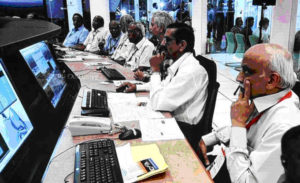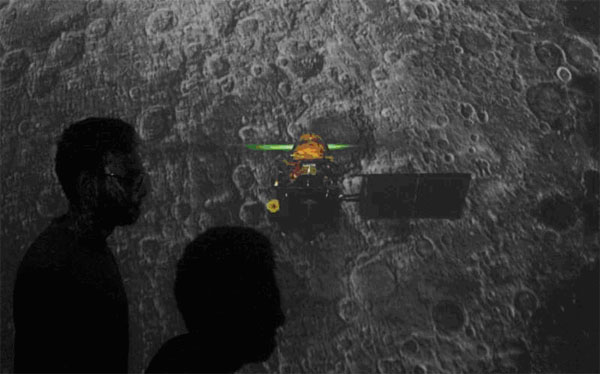India’s Space Agency Loses Contact With Craft Moments Before Moon Landing
07 September 2019
Student walk past a screen during a live streaming of Chandrayaan-2 landing at an educational institute in Mumbai, India, September 7, 2019.
India’s space agency lost contact with the lander Friday. It appeared to be on its way to landing before images on a computer screen appeared to freeze.Then, an official with the Indian Space Research Organization made a solemn announcement.”The communications from the lander to ground station was lost. The data is being analyzed,” ISRO chief Kailasavadivoo Sivan told mission control
“We came very close. But, we will need to cover more ground in the times to come,” Prime Minister Narendra Modi said in an address Saturday morning, thanking the scientists behind the effort to try to set the Chandrayaan-2’s Vikram lander on the Moon’s south pole.
A TV grab shows ISRO scientist reacting after the communication and data were lost from the vikram lander at ground station ISRO on Sept. 7.

The Indian Space Research Organization’s (ISRO) second lunar mission “Chandrayaan-2” is expected to explore the Moon’s south polar region, making the country the first to do so. The spacecraft, Vikram lander, is expected to touchdown the lunar South Pole region. It’s rover, Pragyan, will collect samples that will help the scientists to better understand about the origin and evolution on the moon and will make India fourth nation after US, Russia and China, to land a spacecraft on the Moon.
Sept. 7, 2019: Vikram Lander loses its path
.A successful landing would have made India one of four nations to put a craft on the moon and the first to touch down near the lunar south pole.Only the U.S., Russia and China have landed spacecraft on the moon. An attempt by Israel in April failed.
Modi called the effort the most ambitious for the country’s space program, saying “we are full of confidence that when it comes to our space program” and “the best is yet to come.” He said the experience of launching the spacecraft and trying to land it was as important as the final result.”I can proudly say that the effort was worth it, and so was the journey,” he said. “Our team worked hard, traveled far, and those teachings will always remain with us. … There will be a new dawn and a brighter tomorrow very soon.”The Chandrayaan-2 orbiter launched into space on July 22 and has been circling the moon since Aug. 20.The 3,200-pound lander was carrying a six-wheeled rover named Pragyan, as well as a suite of scientific instruments.
The Indian Space Research Organisation’s (ISRO) Chandrayaan-2 (Moon Chariot 2), with on board the Geosynchronous Satellite Launch Vehicle (GSLV-mark III-M1), launches at the Satish Dhawan Space Centre in Sriharikota, an island off the coast of southern Andhra Pradesh state, on July 22, 2019. – India launched a bid to become a leading space power on July 22, sending up a rocket to put a craft on the surface of the Moon in what it called a “historic day” for the nation. (Photo by ARUN SANKAR / AFP) (Photo credit should read ARUN SANKAR/AFP/Getty Images)
Plans called for the Vikram lander to touch down on a relatively flat plain between two craters. Like all landings on other celestial bodies, the effort was called tricky because of the complicated sequence of rocket firings needed to bring a spacecraft slowly to the surface.
In a press briefing in August, ISRO chairman Sivan called these sequences the mission’s “most terrifying moments.”Modi said Saturday that regardless of the outcome, the scientists working on the mission had “made an incredible contribution to national progress.” He urged them to “stay steady, and look ahead.”
Courtesy: MSNNews

